Halloween
Scotland Celebrates Unique Halloween Traditions
Experience Scotland's enchanting Halloween customs, from neep lanterns to guising, blending tradition and mystery – uncover the allure.
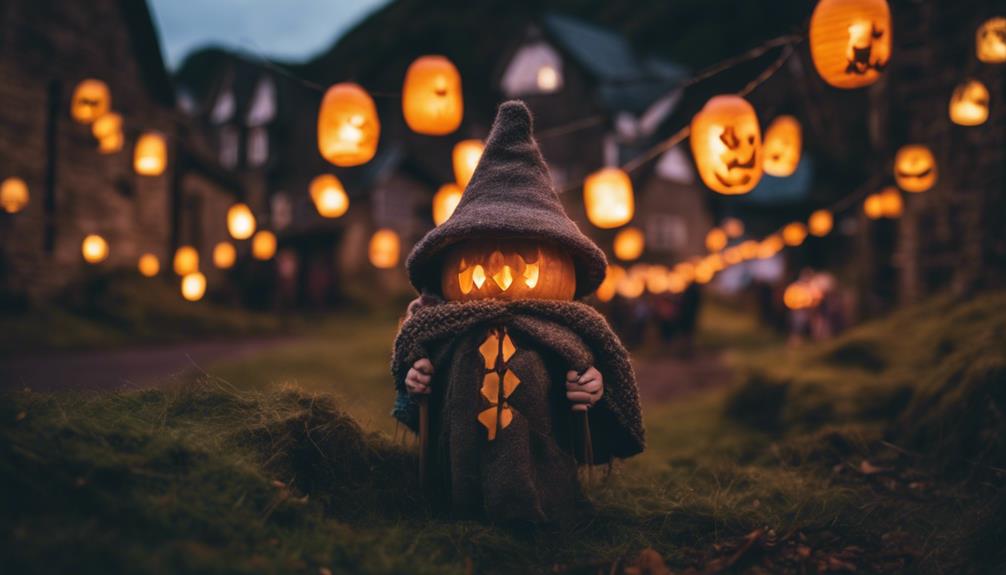
In Scotland, Halloween traditions hold a special charm. Neep lanterns, carved from turnips, are iconic for protection against spirits. Apple dookin, a classic Celtic game, adds fun to the celebrations. Treacle scones, messy but delightful, challenge you to eat without hands and are popular during guising. Nut burning rituals predict marital bliss. Guising involves disguising for treats and community bonding. These customs reflect historical roots and ward off evil. Kale pulling predicts lovers' height and wealth. Tales like Tam O Shanter and Sawney Bean add to the spooky allure. Modern celebrations blend ancient practices for a unique Scottish experience. Additional insights await.
Key Takeaways
- Neep Lanterns: Turnips carved as lanterns for protection with deep roots in Scottish folklore.
- Apple Dookin: Celtic game adding fun to celebrations, creating lasting memories with a unique Scottish tradition.
- Nut Burning Rituals: Couples seek insights into future marital bliss with symbolic rituals.
- Guising: Disguising for treats, fostering community bonding, and connecting to cultural heritage.
- Samhain Festival: Blends ancient customs with modern celebrations, marking the Celtic New Year in Edinburgh.
Neep Lanterns and Their Significance
Neep lanterns have long been an integral part of Scottish Halloween traditions, historically used to ward off evil spirits. In Scotland, communities would intricately carve scary faces into turnips to create these lanterns, symbolizing protection from supernatural forces during Halloween. The tradition of neep lanterns dates back centuries, with each carved turnip serving as a beacon of light to keep malevolent spirits at bay.
These lanterns weren't mere decorations but held significant meaning in Scottish folklore. The eerie glow emitted by the neep lanterns was believed to offer a barrier against otherworldly entities that roamed freely on Halloween night. By placing these carved turnips outside homes or carrying them around, the Scottish people sought to shield themselves from any spiritual harm that may come their way.
Although pumpkins have now become the more common choice for lanterns in modern Scottish Halloween celebrations due to their easier carving process and influence from American culture, the tradition of neep lanterns continues to hold a special place in the hearts of those who cherish Scotland's rich heritage.
Apple Dookin: A Fun Tradition

Adding an element of fun and challenge to Halloween celebrations in Scotland, apple dookin is an ancient Celtic game enjoyed by both children and adults. This tradition has been a staple at Halloween parties in Scotland for generations, bringing laughter and excitement to the festival atmosphere.
Here are some tips to make the most of your apple dookin experience:
- Techniques: Try different tactics like using your teeth, a fork, or even creating innovative strategies to capture the elusive apples.
- Competition: Challenge your friends and family to see who can collect the most apples within a time limit, adding a competitive edge to the game.
- Laughter: Embrace the inevitable hilarity that comes with attempting to grab slippery apples from a tub of water without hands.
- Memories: Create lasting memories as you participate in this unique Scottish tradition, a highlight of Halloween festivities in Scotland.
Treacle Scones: A Halloween Delight

For a messy yet delightful Halloween game that adds a unique twist to traditional festivities, consider trying treacle scones. This Celtic-inspired Halloween tradition involves participants attempting to eat treacle-coated scones without using their hands. The challenge lies in biting into the sticky treat dangling from a string, testing your agility and skill. The game is a fun departure from typical Halloween activities, offering a playful and competitive element to the celebration.
Treacle scones are a popular choice for those engaging in guising, a traditional Halloween practice of dressing up in costumes and going door-to-door for treats. The scones provide a tasty and entertaining way to enjoy the spooky season with friends and family. While it may get a bit messy, the laughter and excitement that come with this unique game make it a memorable experience. So, gather your loved ones, hang up those treacle scones, and get ready for a Halloween delight like no other!
Nut Burning Rituals Explained

Nut burning rituals in Scotland were a traditional way for engaged couples to foretell their future marital bliss. By placing nuts in the fire and interpreting their behavior, couples sought insights into their upcoming union.
The significance of this practice in Scottish culture lies in its connection to folklore and the customs surrounding relationships.
Origins of Ritual
Engaged couples in Scotland engaged in nut burning rituals as a means to predict the future of their relationship. This traditional practice held significant importance in Scottish culture, offering couples a unique way to seek insights into what lay ahead for their union.
Here are some key points to help you understand the origins of this intriguing ritual:
- Predicting Relationship Outcomes: By observing how nuts burned in the fire, couples believed they could foresee whether their marriage would be harmonious or face challenges.
- Symbolic Meanings: The quiet burning of nuts symbolized a peaceful and happy marriage, while hissing and crackling nuts indicated potential difficulties in the future.
- Superstitions and Traditions: Nut burning rituals were deeply rooted in superstitions surrounding marriage and relationships in Scotland.
- Seeking Future Insights: Engaged couples turned to these rituals as a way to gain a glimpse into their future together, hoping for positive outcomes.
Significance in Culture
Signifying a deep-rooted tradition in Scottish culture, the nut burning rituals hold a mysterious allure, offering engaged couples a glimpse into their future marriage outcomes. This practice is closely tied to the ancient Celtic festival of Samhuinn, which marks the end of the harvest season and the beginning of winter. During the Gaelic festival, nut burning rituals play a significant role in Halloween traditions, adding an element of folklore and superstition to the celebrations.
Engaged couples participate in this unique Scottish custom by placing nuts in the fire and listening to the sounds they make as they burn. The interpretation of these sounds is believed to reveal insights into the couple's future relationship. A quiet nut burning denotes a harmonious and joyful marriage ahead, while hissing or crackling nuts may foretell challenges and conflicts. This age-old practice not only adds a touch of mystery to Halloween festivities but also reflects the cultural beliefs and values surrounding relationships and marriage in Scotland.
Guising: Dressing up in Disguise
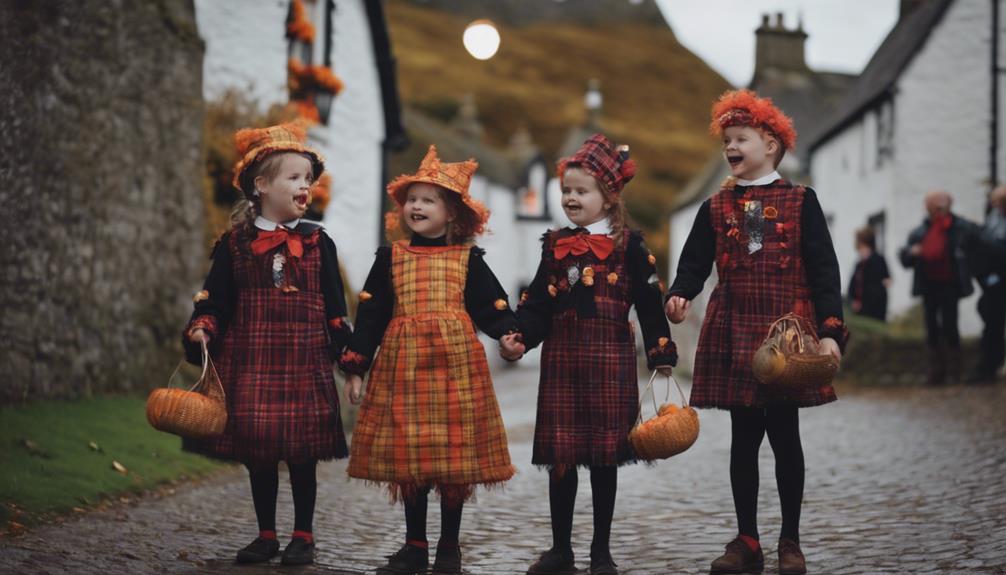
When it comes to guising in Scotland, dressing up is more than just putting on a costume – it's about disguising yourself for treats and protection.
Traditional costume choices for guising often involve spooky or ghostly outfits to ward off evil spirits.
As children dress up and go door-to-door, they not only entertain but also honor the ancient Celtic belief of disguising to stay safe during Halloween.
Disguise for Treats
Dressing up in disguise, known as guising, is a longstanding Halloween tradition in Scotland where children ward off evil spirits by performing tricks or songs in exchange for treats. Here are some fun facts about this unique practice:
- Interactive Tradition: Guising allows children to actively participate in Halloween traditions by engaging with their community in a playful manner.
- Cultural Heritage: This tradition has deep roots in Scottish culture, dating back to times when costumes were believed to protect against malevolent spirits.
- Creative Expression: Children get to showcase their creativity by choosing costumes that range from spooky to whimsical, adding to the festive spirit of Halloween.
- Community Bonding: Guising fosters a sense of camaraderie among neighbors as they enjoy the performances and treat exchanges, creating a warm and inclusive atmosphere on Halloween night.
Guising isn't only a fun way for children to celebrate Halloween but also a tradition that connects them to Scotland's rich cultural heritage.
Traditional Costume Choices
Guising in Scotland involves selecting traditional costumes such as old clothes, masks, or blackened faces to participate in the Halloween tradition of dressing up in disguise. This practice dates back to ancient times when people believed that evil spirits roamed the earth during Halloween. By wearing disguises, guisers aimed to blend in with these spirits, protecting themselves from any potential harm.
Authenticity is key when it comes to choosing costumes for guising in Scotland. Rather than opting for modern outfits, the focus is on historical and traditional attire that reflect the roots of Scottish Halloween traditions. Children participating in guising wouldn't only wear these costumes but also perform tricks or sing songs in exchange for treats like fruits, nuts, or cakes.
The combination of costumes and performance plays a significant role in warding off spirits and celebrating the spirit of Halloween in Scotland.
Kale Pulling and Its Origins

Originating from Robert Burns's poem 'Halloween', kale pulling is a Scottish Halloween tradition where participants predict their future lover's height and wealth by pulling kale stalks with closed eyes.
Here are some interesting facts about this unique practice:
- The origins of Halloween in Scotland play a significant role in the kale pulling tradition.
- Scottish Halloween festivities often revolve around predicting future relationships, making kale pulling a popular activity.
- The amount of soil around the roots of the kale stalks pulled signifies the wealth of the future lover.
- Participating in kale pulling adds a touch of mystique and tradition to Scottish Halloween customs, creating a fun and festive atmosphere during the celebrations.
Kale pulling not only connects modern-day Scots to their historical roots but also adds a whimsical element to Halloween celebrations, making it a cherished tradition that continues to thrive in Scotland.
Tam O Shanter: a Spooky Tale

In the eerie tale of 'Tam O Shanter' by Scottish poet Robert Burns, supernatural beings like witches, warlocks, and the devil lurk, adding a chilling atmosphere to the narrative. This ancient Scottish poem follows Tam, a farmer who encounters these otherworldly creatures during a fateful night. The story is rich in suspense and haunting elements, capturing the essence of Scottish Halloween folklore.
In 'Tam O Shanter,' the vivid descriptions of witches and warlocks contribute to the eerie ambiance, making it a classic in Scottish literature. The tradition of guising, where people dress in costumes to ward off evil spirits, is also reflected in the tale. As you explore the world of 'Tam O Shanter,' you'll experience the essence of Scottish storytelling at its finest.
The use of a neep lantern, a hollowed-out turnip with a candle inside, adds to the spooky atmosphere of the narrative, enhancing the overall Halloween spirit.
Sawney Bean: The Scottish Legend

Hidden in the depths of Scottish folklore lies the chilling tale of Sawney Bean and his notorious family of cannibals. The story of Sawney Bean's cannibalistic activities dates back to the 16th century in Scotland, specifically along the Ayrshire coast, where they lived in a hidden cave. Here are some intriguing facts about this Scottish legend:
- Sawney Bean is a legendary figure in Scottish folklore known for his gruesome cannibalistic activities.
- The story of Sawney Bean and his family of cannibals is said to have taken place in the 16th century in Scotland.
- Sawney Bean and his clan reportedly lived in a hidden cave along the Ayrshire coast where they ambushed and devoured unsuspecting travelers.
- The legend of Sawney Bean has been passed down through generations, with various accounts detailing the horrors of his crimes.
Sawney Bean's tale has become a prominent part of Scottish folklore, inspiring numerous adaptations in books, movies, and plays that continue to captivate audiences with the dark saga of this infamous figure.
Modern Scottish Halloween Celebrations

The rich tapestry of Scottish Halloween traditions extends beyond the eerie legend of Sawney Bean, immersing you in the vibrant modern celebrations that embody the spirit of this festive occasion.
In Scotland, trick-or-treating is known as guising, where children perform tricks for treats like fruit, nuts, or cakes. The repeal of the Witchcraft Act of 1735 in the 1950s paved the way for modern Scottish Halloween festivities to flourish, allowing traditions like bobbing for apples and making pumpkin lanterns to thrive.
The Samhain Festival in Edinburgh marks the Celtic New Year with a grand event that blends ancient traditions with modern celebrations, bringing communities together in a unique way. Children continue the tradition of guising, dressing up in costumes and performing for rewards, keeping the spirit of Halloween alive in Scotland's own special manner.
Frequently Asked Questions
How Is Samhain Celebrated in Scotland?
In Scotland, Samhain is celebrated on October 31st to mark the end of summer and harvest season. Traditional bonfires are lit to ward off evil spirits, and turnip lanterns, called neep lanterns, historically protected against malevolent forces.
The ancient Celtic festival of Samhain has influenced modern Halloween traditions. Festivities include rituals, games, and activities to honor the shift between the living and the dead.
What Is the Scottish Word for Trick-Or-Treating?
The Scottish word for trick-or-treating is 'guising.' When you're in Scotland, remember to dress up and go 'guising' instead of saying 'trick-or-treat.'
Kids put on costumes, recite poems, sing songs, or tell jokes to get sweets or fruit. It's a fun way to celebrate Halloween and dates back to ancient Celtic customs.
What Unique Traditions Does England Have for Halloween?
In England, Halloween traditions include 'souling,' where people sing for soul cakes, and mumming, a form of play-acting. Folklore tells of Black Shuck, a ghostly black dog. Toffee apples, parkin, and soul cakes are traditional foods.
Some regions have unique customs like 'punkie night' in Somerset, where children carve lanterns from mangel wurzels. These customs add a fun and spooky flair to England's Halloween celebrations.
What Unique Traditions Does Europe Have for Halloween?
Europe boasts diverse Halloween traditions. Countries like Ireland have a rich folklore, including tales of the banshee.
In Italy, All Saints' Day is celebrated with special pastries. France enjoys pumpkin carving and costume parties.
Germany's Walpurgis Night features bonfires. Eastern European countries, such as Romania, embrace customs like lighting candles to honor the deceased.
Each nation adds its unique flair to the spooky holiday festivities.
Conclusion
So, next time you find yourself in Scotland during Halloween, be sure to embrace their unique traditions. From Neep Lanterns to Tam O Shanter tales, there's something for everyone to enjoy.
Just remember, when you're bobbing for apples or pulling kale, you never know what spooky surprises await.
Embrace the magic of Scotland's Halloween celebrations, and who knows, you might just have a hauntingly good time!
Hello, I’m Damien, the editor-in-chief here at Halloween Product Reviews. As a lover of all things Halloween, my goal is to be your one-stop resource. Whether you’re seeking costumes, decorations, or just looking to embrace the festive spirit, our expert team is here to assist in making your Halloween truly spectacular. My personal joy comes from dressing up, decorating my home, and diving into the Halloween festivities. I’m here to help make your Halloween as spooky and fun as possible!
Halloween
Do You Get Halloween Off?
Wondering if you get Halloween off? Find out how to navigate Halloween at work and make the most of the spooky season!
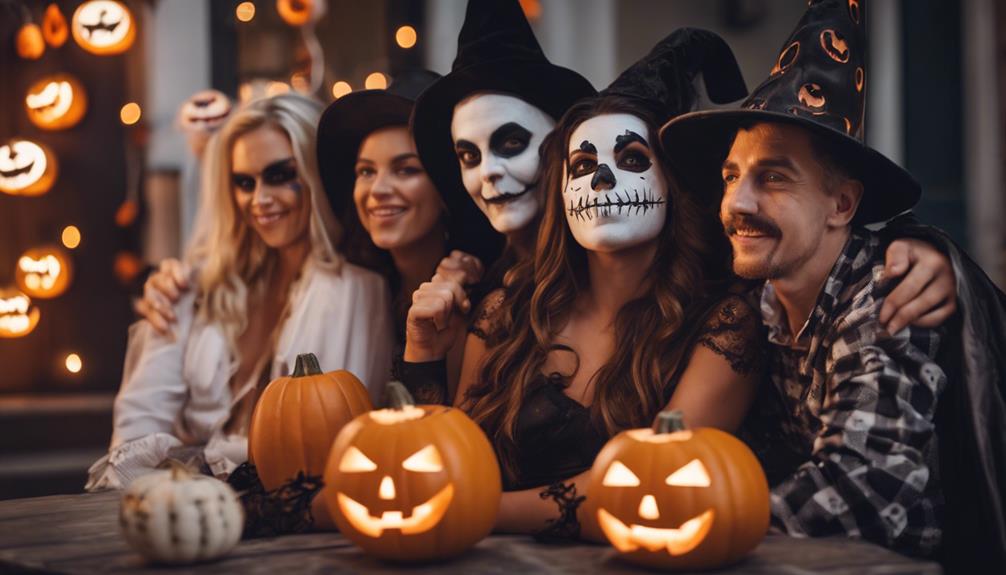
If you're curious about managing Halloween at work, it hinges on your employer's rules and whether Halloween is recognized as a holiday at your job. Some companies grant time off, while others may not formally acknowledge Halloween. Understanding your workplace's stance can help you make plans for the day. Depending on your company, you might be able to enjoy Halloween festivities in various ways. To explore more about handling Halloween at work and finding the right balance, keep learning about Halloween policies, celebrations, and harmonizing your work-life blend in the sections ahead.
Key Takeaways
- Halloween off varies by company policy.
- Some companies offer time off for Halloween.
- Check with HR for Halloween leave.
- Utilize vacation or personal days.
- Flexible scheduling can accommodate Halloween celebrations.
Halloween as a Non-Federal Holiday
Halloween may not grant you a day off work since it isn't a federal holiday in the U.S. Despite not being a federal holiday, Halloween is widely celebrated and recognized across the country.
While it holds no official status as a federal holiday, Halloween is a favorite occasion for many due to its festive nature. The day isn't to be confused with All Saints' Day, a religious observance on November 1st.
Halloween is renowned for its fun traditions like dressing up in costumes, attending parties, and going trick-or-treating. Although it doesn't mean a day off from work, Halloween remains one of the favorite things for people to celebrate, regardless of age.
The lack of federal recognition doesn't diminish the enthusiasm for this festive day filled with spooky decorations, creative costumes, and sweet treats. Though you may not have the day off, you can still enjoy the spirit of Halloween after work hours.
Work Policies on Halloween

On Halloween, many companies have varying policies regarding time off, costume wearing, and activities like trick-or-treating in the workplace.
It's important to familiarize yourself with your company's specific guidelines to make sure you follow appropriate protocols and contribute positively to the Halloween spirit at work.
Understanding these policies can help you navigate the day smoothly and enjoy the festivities while maintaining professionalism.
Halloween Time off
Employees at various companies may enjoy flexibility in their schedules or attire choices during Halloween. Since Halloween isn't a federal holiday, most workers don't automatically have the day off. However, some companies may allow employees to adjust their schedules or dress up in costume to celebrate the occasion.
Work policies surrounding Halloween time off differ depending on the employer and industry. While Halloween observance at work could involve themed activities or costume contests, these celebrations typically don't disrupt the regular work schedule. It's important to check with your employer or HR department to understand their specific policies regarding Halloween in the workplace.
Company Costumes Policy
During Halloween season, understanding your company's costume policy can enhance your festive experience at work. Some companies have specific policies in place that either allow or restrict employees from wearing costumes on Halloween. These policies often align with the company's overall dress code to make sure that the costumes chosen are appropriate for the workplace setting. To give you a better idea of what to expect, here is a table summarizing common company costume policies:
| Company Costume Policy | Description |
|---|---|
| Costumes Allowed | Employees are encouraged to dress up and participate in Halloween activities. |
| Costumes Restricted | Employees are advised against wearing costumes to maintain a professional environment. |
| Costume Contests | Companies may organize contests to promote Halloween spirit while adhering to guidelines. |
| Themed Activities | Employers might plan themed events where employees can participate in a specific dress code. |
Being aware of your company's costume policy can help you navigate Halloween festivities at work smoothly and avoid any misunderstandings.
Trick-Or-Treating at Work
Understanding your company's approach to trick-or-treating at work during Halloween can greatly impact your festive experience and workday dynamics. Here are some ways workplaces may handle Halloween celebrations:
- Some companies set up candy stations or organize costume contests for employees to participate in trick-or-treating at work.
- Work policies on Halloween may include relaxed dress codes to accommodate costumes and themed attire, adding a fun touch to the day.
- Employers may foster team spirit by encouraging activities like pumpkin carving or Halloween-themed games, creating a festive atmosphere.
- To balance work and play, some workplaces establish designated hours for Halloween celebrations, ensuring minimal disruption to daily tasks.
Celebrating Halloween at Work

Amidst the usual office routine, the excitement of Halloween can infuse a playful spirit into the workplace environment. Some companies embrace this festivity by allowing employees to dress up for Halloween at work. It's not uncommon to see colleagues sporting creative costumes, adding a touch of fun to the day.
Additionally, Halloween-themed activities and decorations may be incorporated into the work environment, creating a festive ambiance.
Workplaces often go the extra mile by hosting Halloween events or contests to engage employees in the celebrations. These events can range from pumpkin carving competitions to costume contests, fostering team spirit and camaraderie.
Flexible schedules or dress codes might also be permitted on Halloween to boost morale and allow employees to fully participate in the festivities.
Balancing Work and Halloween Festivities
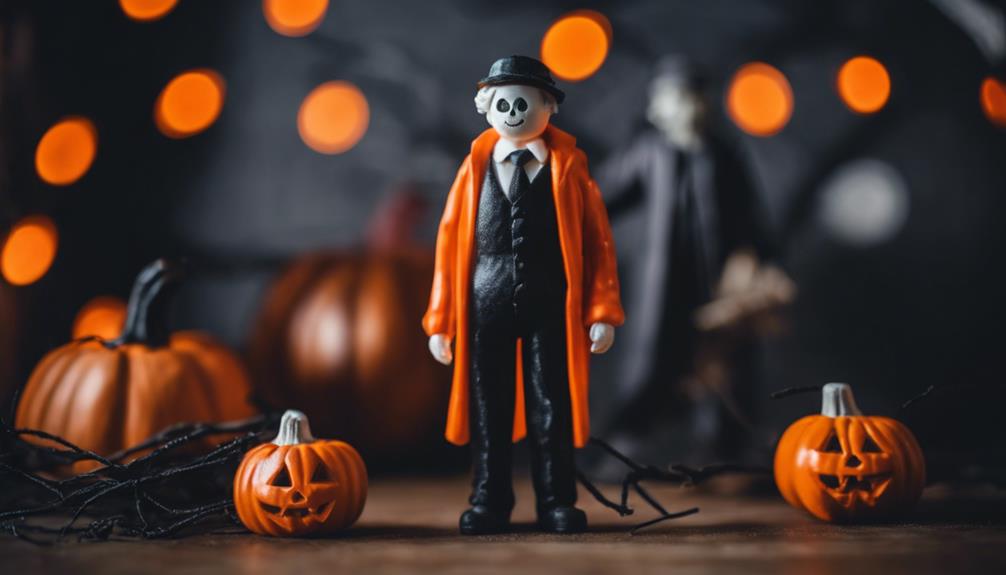
Are you finding the balance between work responsibilities and Halloween festivities challenging as a working professional? It's common to juggle your work commitments with the desire to enjoy Halloween celebrations.
Here are some tips to help you maintain a sense of equilibrium:
- Prioritize Tasks: Make a to-do list to organize your work responsibilities efficiently, allowing you to carve out time for Halloween activities.
- Communicate with Your Team: Discuss workload distribution with your colleagues to make sure tasks are covered while you participate in Halloween events.
- Set Boundaries: Establish clear boundaries between work hours and personal time to fully engage in Halloween festivities without work interruptions.
- Plan Ahead: Schedule Halloween activities in advance, coordinating with your work calendar to avoid last-minute conflicts.
Halloween Events in Companies
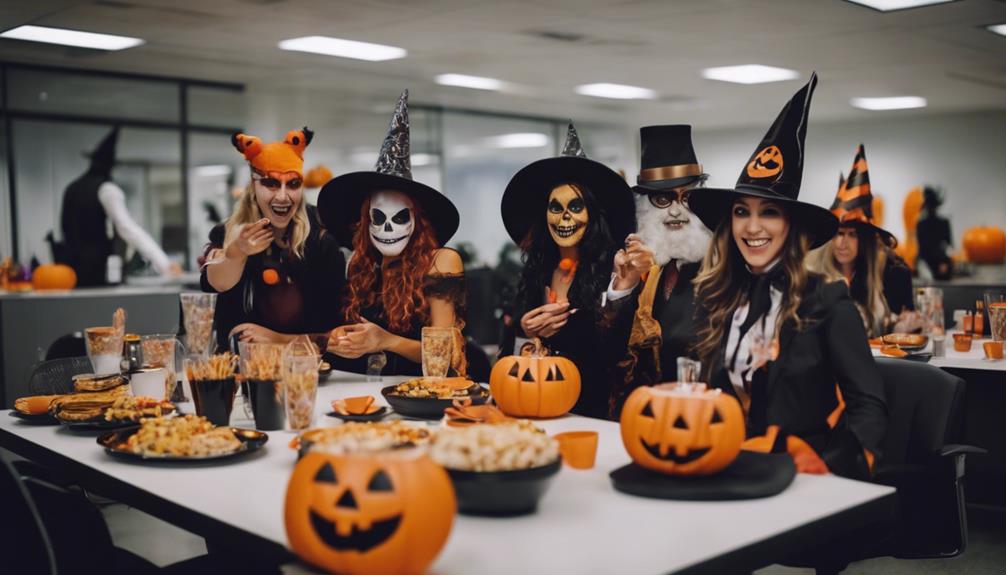
Companies often eagerly host lively Halloween events to boost employee morale and foster a fun work environment. These events can range from costume contests to themed decorations that transform the office into a spooky delight. Some companies take it a step further by organizing trick-or-treating or Halloween-themed activities for employees and their families. This not only allows for a festive atmosphere but also encourages a sense of community within the workplace.
Employees often eagerly anticipate the chance to dress up in costumes and participate in office Halloween parties. These events provide a break from the usual work routine and offer a chance for coworkers to bond over shared experiences. By promoting team building and camaraderie, Halloween events in companies can strengthen relationships among colleagues. So, don't be surprised if your company encourages a bit of Halloween fun – it's all part of creating a positive and engaging work environment.
School Celebrations on Halloween

Schools also embrace the Halloween spirit by hosting lively celebrations complete with costume contests and themed activities that engage students of all ages. This festive tradition allows students to showcase their creativity and immerse themselves in the spooky fun of Halloween. Here are some common elements you might find in school Halloween celebrations:
- Costume Contests: Students enthusiastically dress up in a variety of costumes, from classic monsters to popular characters, competing to win prizes for the best outfits.
- Themed Activities: Schools organize themed activities like pumpkin decorating, mummy wrapping contests, and haunted house tours to keep the Halloween excitement going throughout the day.
- Halloween Parades: High schools often arrange Halloween parades where students can strut their stuff in their costumes, showcasing their spooky and creative attire to their peers.
- Special Assemblies: Some schools hold special Halloween assemblies with performances, skits, or spooky storytelling sessions to add an extra layer of fun to the day.
Halloween and Work-Life Balance
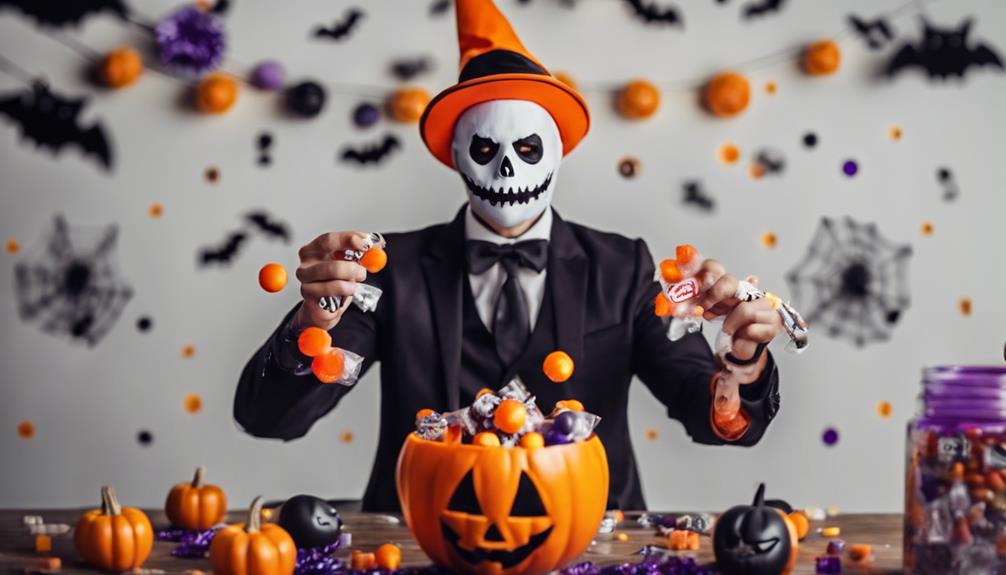
When it comes to balancing work and Halloween festivities, it's all about finding that sweet spot of work-life harmony.
With many companies not offering Halloween as a day off, you may need to navigate time-off policies and flexible schedules to make room for celebrations.
Prioritizing tasks, planning ahead, and possibly adjusting your work schedule can help you strike a balance between work commitments and Halloween fun.
Work-Life Harmony
Working towards achieving a harmonious blend between your professional commitments and the spirited essence of Halloween can greatly enhance your overall well-being and satisfaction in the workplace. To strike a balance between work and Halloween celebrations, consider the following:
- Flexible Work Schedules: Take advantage of any flexible work arrangements your company offers during Halloween to manage both your work responsibilities and festive activities effectively.
- Team-Building Halloween Activities: Engage in Halloween-themed team-building exercises to foster a sense of camaraderie and enjoyment among colleagues while staying productive.
- Positive Work Environment: Embrace Halloween celebrations at work as they can create a fun and positive atmosphere, contributing to higher morale and improved relationships with your coworkers.
- Increased Productivity: By balancing your work responsibilities with Halloween festivities, you can boost your engagement levels, leading to enhanced productivity and overall well-being.
Time Off Policies
Considering the absence of dedicated time off for Halloween in many workplaces, employees may need to utilize alternative leave options to partake in festive activities while maintaining a work-life balance. To navigate this situation effectively, understanding your company's time off policies is essential. Here is a breakdown of common leave options employees might consider for Halloween:
| Leave Option | Description |
|---|---|
| Vacation Days | Use accrued vacation days for a full day off to celebrate Halloween with friends and family. |
| Personal Days | Take a personal day to enjoy Halloween festivities or extend a weekend for a longer celebration. |
| Flex Time | Check if your workplace offers flexible scheduling, allowing you to adjust your hours for Halloween events. |
| Compensatory Time | Some companies offer comp time for working extra hours, which can be used for time off on Halloween. |
| Unpaid Leave | As a last resort, consider requesting unpaid leave if other options are not available or feasible. |
Frequently Asked Questions
Do We Get a Holiday on Halloween?
You don't typically get a holiday on Halloween since it's not a federal holiday in the U.S. However, many companies and schools may still have Halloween events or allow dressing up.
Halloween, celebrated on October 31st, involves activities like trick-or-treating and costume parties. While work schedules vary, some organizations offer flexible hours or themed activities to embrace the Halloween spirit.
Check with your employer to see if any special arrangements are made for Halloween.
Is Halloween Holiday Pay?
Halloween is typically not considered a holiday with paid time off like traditional federal holidays. Most employers don't provide holiday pay for Halloween unless it falls on a designated paid holiday. It's usually treated as a regular workday, and employees are expected to work unless specified by their employer.
Some companies may offer special incentives or bonuses for working on Halloween, but it's not standard holiday pay. Check your company's policies or employment contract for details.
Why Is Halloween Not a Day Off?
Halloween isn't a recognized federal holiday, so workers typically don't have the day off. This lack of time off for Halloween is due to it not meeting the criteria for a federal holiday like Christmas or Thanksgiving.
Employers don't usually provide time off for Halloween, as it isn't an official holiday. As a result, people usually work on Halloween, as it isn't a designated day off in most workplaces.
How Long Does Halloween Last For?
Halloween typically lasts for one day on October 31st, with main celebrations happening in the evening. Some communities may extend festivities to the closest weekend. Parties and events can continue throughout the weekend following October 31st.
Trick-or-treating and costume parties are concentrated on the 31st. It's a fun time for spooky activities and dressing up to enjoy the Halloween spirit. Get ready for a thrilling time!
Conclusion
To sum up, whether or not you get Halloween off from work can vary depending on your company's policies. It's important to communicate with your employer and find a balance between work responsibilities and enjoying the spooky festivities.
Remember, work-life balance is like a well-crafted pumpkin carving – it takes time and effort, but the end result is worth it.
So go out there, have some fun, and make sure to save some candy for later!
Hello, I’m Damien, the editor-in-chief here at Halloween Product Reviews. As a lover of all things Halloween, my goal is to be your one-stop resource. Whether you’re seeking costumes, decorations, or just looking to embrace the festive spirit, our expert team is here to assist in making your Halloween truly spectacular. My personal joy comes from dressing up, decorating my home, and diving into the Halloween festivities. I’m here to help make your Halloween as spooky and fun as possible!
Halloween
Do Nurses Wear Halloween Costumes to Work
Curious about nurses wearing Halloween costumes to work? Consider the creative ways they balance patient care and festive spirit.

Nurses sometimes wear Halloween costumes to work, keeping patient care and professionalism in mind. Costume choices consider patient comfort and safety while maintaining a festive spirit. In pediatric areas, colorful and fun costumes are popular, whereas critical care units lean towards practical and professional attire. Personal experiences and patient sensitivities influence nurses' costume decisions. Balancing holiday cheer with patient care needs is key. If curious about how nurses handle Halloween attire, there are factors like workplace policies, patient demographics, and personal preferences influencing their choices.
Key Takeaways
- Nurses may wear Halloween costumes to work depending on the healthcare setting.
- Consider patient comfort, professionalism, and workplace guidelines before dressing up.
- Pediatric units often embrace costumes for a festive atmosphere.
- Critical care units and psychiatric settings prioritize professionalism over costumes.
- Nurses balance holiday spirit with patient care needs when choosing costumes.
Considerations for Halloween Costumes in Healthcare
When selecting Halloween costumes for work in healthcare, prioritize patient comfort and safety above all else. As a nurse, your choice of costume can have a significant impact on how patients perceive you and the overall atmosphere of the healthcare setting on Halloween.
In pediatric settings, dressing up in fun and colorful costumes can bring joy to young patients and create a festive environment. However, in critical care units, practicality and professionalism should take precedence over elaborate costumes. It's vital to take into account the nature of your work environment and the needs of your patients before deciding on a Halloween costume.
Personal experiences and patient sensitivities should also influence your decision, as what may be appropriate in one specialty, like psych units, may not be suitable in others, such as the NICU. Balancing the holiday spirit with patient care needs is important in making the right choice when it comes to wearing Halloween costumes in healthcare.
Impact of Halloween Costumes on Patient Care

Wearing Halloween costumes as a nurse can impact patient care by influencing their comfort levels and perceptions of your professionalism. Patients may feel more at ease with a friendly, festive nurse, but it's important to balance this with maintaining a professional image to guarantee confidence in your abilities.
Finding the right balance between patient comfort and professional demeanor is essential to providing quality care while embracing the spirit of Halloween.
Patient Comfort With Costumes
Patient comfort is an essential consideration when healthcare professionals choose to incorporate Halloween costumes in their work attire. When a nurse decides to wear a costume to work, it's important to assess how it may impact the comfort of patients.
Some patients might find costumes amusing and uplifting, fostering a positive rapport; however, others may feel unsettled or anxious. Balancing the enthusiasm and rapport-building aspect of costumes with the need to make sure patients feel safe and comfortable is key.
Since there are no universal guidelines on nurses wearing costumes in patient care areas, it's essential for nurses to be mindful of individual patient preferences. While some patients may enjoy the festive spirit brought by costumes, others might prefer a more traditional approach.
Hence, considering patient comfort when donning a Halloween costume at work is crucial for maintaining a high standard of care and ensuring a positive patient experience.
Professional Image Maintenance
Maintaining a professional image while incorporating Halloween costumes into your work attire is essential for ensuring excellent patient care quality. When considering whether to wear costumes at work, it's important to keep the following points in mind:
- Professionalism: In sensitive environments such as critical care units or psychiatric settings, maintaining a serious and professional demeanor is vital. Inappropriate costumes can undermine the seriousness of the work being done and impact patient trust.
- Patient Care: Your attire can influence patient perceptions and interactions. When delivering difficult news, wearing a Halloween costume mightn't convey the level of empathy and seriousness required for the situation. Ensuring that patients feel comfortable and respected is paramount.
- Balancing Act: While dressing up can bring joy and boost morale, finding the right balance between holiday spirit and professionalism is key. Consider the impact your costume may have on different patient populations and adjust accordingly to provide excellent care.
Professionalism Vs Festivity: Finding the Balance

When deciding whether to wear Halloween costumes to work as a nurse, it's crucial to strike the right balance between professionalism and festivity.
Consider the impact your choice may have on patient care and the appropriateness of costumes for different healthcare settings.
Costume Guidelines in Healthcare
Balancing professionalism with festivity in healthcare settings during Halloween involves adhering to written costume guidelines. When deciding on a Halloween costume to wear at work in a healthcare setting, it's important to keep in mind the following:
- Professionalism: Choose costumes that reflect the high standards of professionalism expected in healthcare. Avoid costumes that are revealing, offensive, or inappropriate for a medical environment.
- Patient Comfort: Prioritize patient comfort by selecting costumes that aren't overly scary, gory, or distressing. Remember that patients may already be in vulnerable situations, so it's crucial to maintain a calming and respectful atmosphere.
- Respect for Cultural Sensitivity: Be mindful of cultural differences and sensitivities when selecting a costume. Avoid outfits that could be misinterpreted or deemed disrespectful by patients from diverse backgrounds.
Impact on Patient Care
To strike the right balance between professionalism and festivity in healthcare settings during Halloween, consider the impact on patient care when deciding on wearing Halloween costumes to work.
Maintaining professionalism is important, particularly in delivering serious news or in critical care units where a somber atmosphere is essential. In situations like psychiatric units or when interacting with families experiencing difficult times, costumes may not be appropriate as they could be perceived as insensitive.
However, nurses working with children may find dressing up more acceptable and enjoyable for young patients, helping to create a positive and comforting environment.
It's essential to find the right balance between embracing the holiday spirit and upholding professionalism when contemplating whether to wear Halloween costumes to work. By carefully considering the impact on patient care, you can make an informed decision that aligns with the needs of both your colleagues and those under your care.
Workplace Policies on Halloween Attire

Workplace policies regarding Halloween attire for nurses vary depending on the hospital's culture and specialty areas. Here are some key points to keep in mind:
- Written Guidelines: Some hospitals have specific policies that allow nurses to wear Halloween costumes to work. These guidelines may outline what's deemed important attire, ensuring that professionalism is maintained even during festive occasions.
- Variability Based on Culture: Workplace policies on Halloween attire differ greatly across healthcare settings. While some hospitals may encourage festive participation, others may have stricter guidelines, especially in units like critical care or psych, where maintaining a serious and professional environment is essential.
- Subtle Participation: In environments where full costumes mightn't be suitable, nurses can still join in the Halloween spirit by opting for subtle accessories like themed headbands or earrings. This allows for a touch of festivity without compromising the necessary level of professionalism required in healthcare settings.
Patient Demographics and Costume Choices

Considering the patient demographics, nurses may select Halloween costumes that align with the age groups and preferences of those they care for. In hospitals, especially pediatric units where 38% of children are aged 6-17, nurses often choose to wear festive costumes to brighten up the atmosphere for young patients. Pediatric nurses, in particular, may opt for fun and colorful costumes to create a positive and cheerful environment for the children they look after.
Costume choices can vary across different hospital departments based on the demographics of the patients they serve. By taking into account the age groups and preferences of their patients, nurses can make thoughtful decisions about whether to incorporate Halloween attire into their work wardrobe. This consideration not only adds a touch of joy to the hospital setting but also demonstrates the nurses' efforts to connect with and uplift the spirits of those under their care.
Personal Preferences and Dress-Up Decisions

Patient demographics play a role in nurses' costume choices at work, but ultimately, it's your personal preferences that dictate whether you decide to dress up for Halloween in a healthcare setting. If you find yourself in a workplace where coworkers are wearing costumes, you might feel more inclined to join in on the fun.
On the other hand, if you're a nurse asked to trade your scrubs for a costume in a more serious or sensitive environment, you may choose to politely decline based on your comfort level. It truly depends where you work. Some healthcare settings may embrace the Halloween spirit, while others prioritize professionalism above all else.
Take into consideration the atmosphere of your workplace and how your choice to dress up may impact your interactions with patients and colleagues. Ultimately, the decision to wear a Halloween costume to work as a nurse is a personal one that should be made with careful consideration of the setting and your own preferences.
Examples of Appropriate Halloween Attire for Nurses

When selecting Halloween attire to wear as a nurse, prioritize practicality and comfort to guarantee it complements your scrubs and allows for easy movement. If you work in pediatrics, consider fun and colorful costumes that can bring a smile to your young patients' faces while maintaining a professional appearance.
Opt for costumes that allow you to perform your duties without any hindrance, such as superhero-inspired outfits or costumes inspired by iconic figures. Accessories like festive headbands or earrings can add a touch of Halloween spirit without being overwhelming.
Simple do-it-yourself costumes, like animals with face paint or pun-themed ideas, are also great options that can be both easy to put together and enjoyable to wear. Remember, the key is to balance the festive spirit of Halloween with the practical requirements of your job to guarantee a comfortable and appropriate attire choice for your shift.
Frequently Asked Questions
What Do Nurses Wear to Work on Halloween?
When deciding what to wear to work on Halloween, nurses often opt for costumes based on the hospital's culture and policies. In pediatric settings, some may choose fun costumes to engage with young patients. However, consider appropriateness when interacting with patients and families.
Departments like psychiatric units or critical care settings may prioritize professionalism. Festive accessories like earrings or headbands can offer a subtle way to join in the Halloween spirit at work.
Is It Appropriate to Wear Halloween Costumes to Work?
It's imperative to contemplate professionalism when deciding whether to wear Halloween costumes to work.
While it can be fun in certain settings, like pediatric wards, it may not be appropriate in all healthcare environments. Make sure your costume is respectful and won't hinder your ability to provide care.
Opt for festive accessories if a full costume isn't suitable. Remember, your priority is always patient care, so choose your attire wisely.
Is a Nurse a Halloween Costume?
A nurse isn't a Halloween costume. A nurse is a healthcare professional trained to provide medical care to patients.
While some nurses may choose to wear Halloween costumes at work to join in the holiday fun, being a nurse isn't a costume but a respected profession.
It's important to maintain professionalism and adhere to workplace dress codes while celebrating Halloween in a manner that's appropriate and respectful to the nursing profession.
What Do Nurses Wear to Work?
When you head to work, nurses typically wear scrubs, the go-to uniform in many hospitals. These outfits aren't just a fashion statement but also practical for the demanding work environment. Scrubs offer comfort, easy movement, and a professional appearance.
Hospitals often have guidelines on appropriate attire to guarantee safety and hygiene. It's crucial to dress smartly and comfortably to focus on providing excellent care to your patients.
Conclusion
In the world of healthcare, Halloween costumes can be a tricky subject. While it may be tempting to dress up for the holiday, it's important to contemplate how it may impact patient care and professionalism.
Finding the balance between fun and appropriate attire is key. Remember, your priority is always the well-being of your patients. So, when in doubt, opt for subtle and tasteful costumes that won't distract from your important work.
Stay safe and spooky, nurses!
Hello, I’m Damien, the editor-in-chief here at Halloween Product Reviews. As a lover of all things Halloween, my goal is to be your one-stop resource. Whether you’re seeking costumes, decorations, or just looking to embrace the festive spirit, our expert team is here to assist in making your Halloween truly spectacular. My personal joy comes from dressing up, decorating my home, and diving into the Halloween festivities. I’m here to help make your Halloween as spooky and fun as possible!
Halloween
7 Things About Halloween Farm's Location
Wander through the enchanting Halloween Farm's Location at Dewberry Farm in Brookshire, Texas, for an unforgettable blend of fall festivities and rural charm…
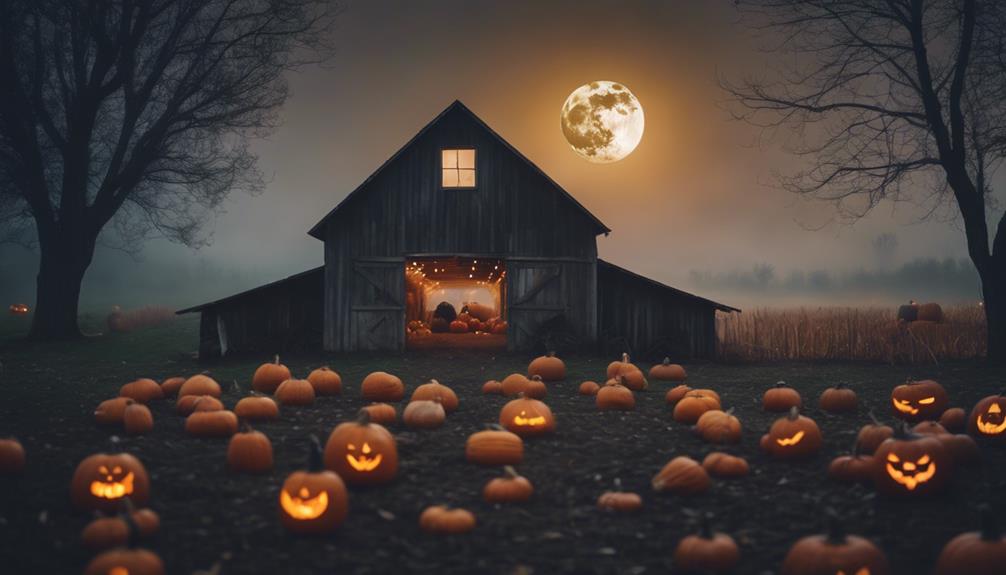
When it comes to Halloween Farm's Location at Dewberry Farm in Brookshire, Texas, prepare for a treat. You'll discover 364 acres of pumpkin patches, hayrides, and ziplining adventures in a serene countryside setting. This spot beautifully combines natural beauty with exciting activities and local charm, making it an ideal destination for a memorable fall day trip. Embrace the picturesque scenery, enjoy the hayrides, and savor the thrilling ziplining experiences. Each visit promises a unique blend of fun and relaxation that you won't want to miss. Explore further to uncover more about the seasonal transformations and accessibility options available to you.
Key Takeaways
- Historic Dewberry Farm in Brookshire, Texas, dating back to the 1800s.
- Knott's Scary Farm in Southern California offers haunted mazes and live shows.
- Dewberry Farm near Houston with easy access and Fall Festival activities.
- Nearby haunted attractions like Nightmare Dungeon and spooky corn mazes.
- Dewberry Farm's unique features include hayrides, ziplining, and a country store.
History of Halloween Farm's Location
Step into the past as you explore the rich history of Dewberry Farm's location, a historic property dating back to the early 1800s in Brookshire, Texas. The farm's roots run deep in the fertile soils of Brookshire, where it has evolved over time into a beloved Halloween Farm. Originally established as a traditional farm in the 19th century, the land witnessed generations of agricultural endeavors before evolving into a festive autumn destination.
The Halloween Farm's location in Brookshire adds an intriguing layer to its allure, blending the nostalgia of the past with the excitement of present-day seasonal activities. As you wander through the sprawling fields and rustic barns, you can sense the echoes of the area's agricultural history intertwined with the festive spirit of Halloween. This unique combination creates a charming rural atmosphere that captivates visitors, inviting them to immerse themselves in both the farm's historical significance and its modern-day enchantments.
Southern California Setting
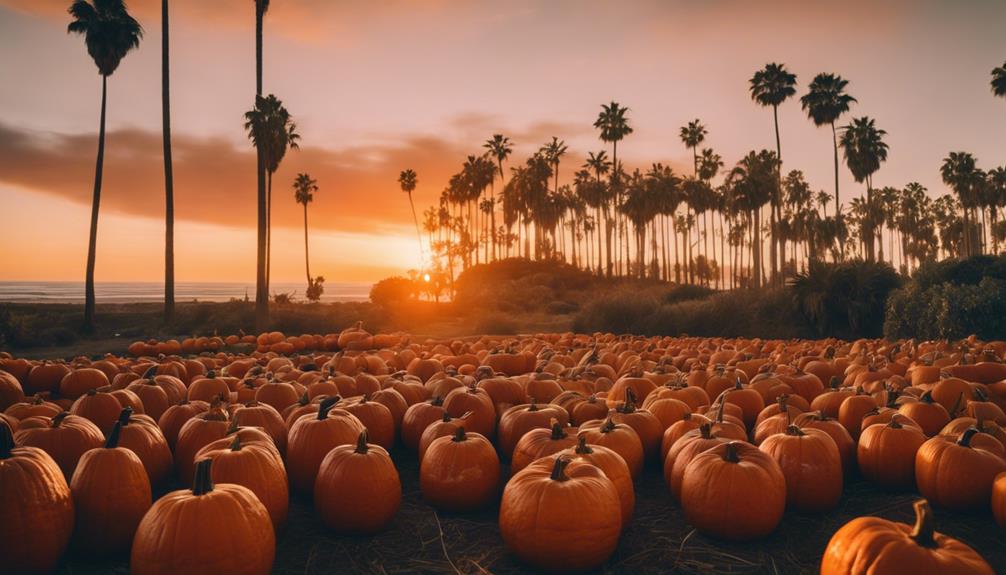
Nestled in Buena Park, Southern California, Knott's Scary Farm sets the stage for a thrilling Halloween experience at the renowned Knott's Berry Farm amusement park. This theme park transforms into a spooky spectacle during the Halloween season, offering visitors a mix of haunted mazes, scare zones, and live shows. The location at Knott's Berry Farm adds an extra layer of excitement, as guests can enjoy both the regular attractions of the amusement park and the special Halloween-themed offerings of Knott's Scary Farm.
Southern California's mild fall climate provides the perfect backdrop for outdoor Halloween events, allowing guests to fully immerse themselves in the spooky atmosphere without worrying about cold weather. Additionally, the vibrant and diverse setting of Southern California enhances the overall experience, making Knott's Scary Farm a must-visit destination for Halloween enthusiasts looking for a mix of thrills and entertainment at a well-established theme park.
Proximity to Major Cities
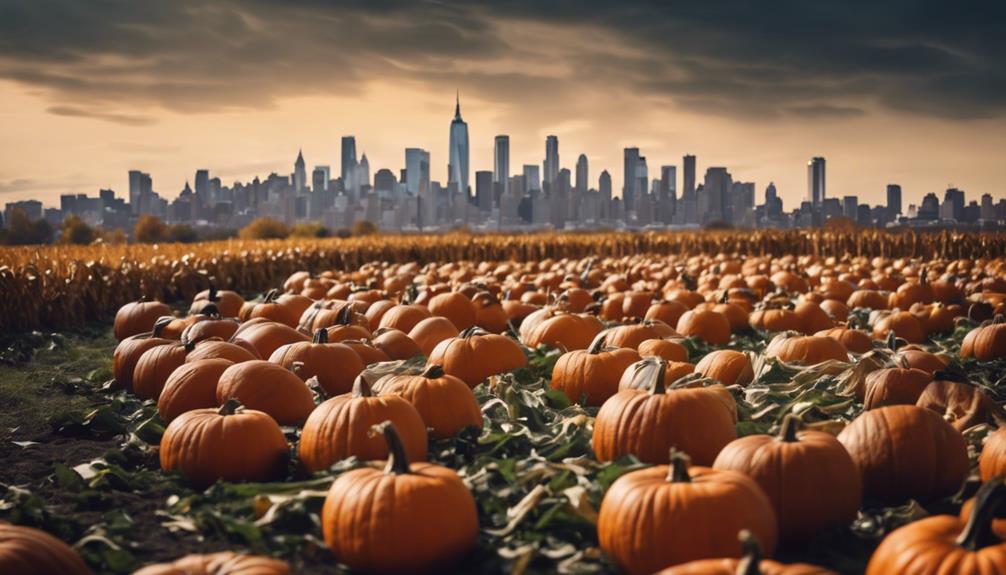
Conveniently located just a short drive away from downtown Houston, Texas, Dewberry Farm offers easy access to visitors seeking a fun Fall Festival experience. If you're coming from Houston or nearby cities, the farm's proximity makes it a convenient destination for a day of festive activities. Take a look at the table below to see how Dewberry Farm compares to other popular locations:
| Farm | Distance from Houston | Features |
|---|---|---|
| Dewberry Farm | 45-50 minutes | Fall Festival, Parking |
| Knott's Berry Farm | Approximately 30 minutes | Amusement Park, Haunted Attractions |
| Haunted Farm | I'm not sure. | Haunted House, Corn Maze |
Whether you're considering Dewberry Farm, Knott's Berry Farm, or a Haunted Farm, Dewberry's easy access and enjoyable Fall Festival make it a great choice for a fun day out. Plus, with free on-site parking, your visit is sure to be hassle-free.
Haunted Attractions Nearby
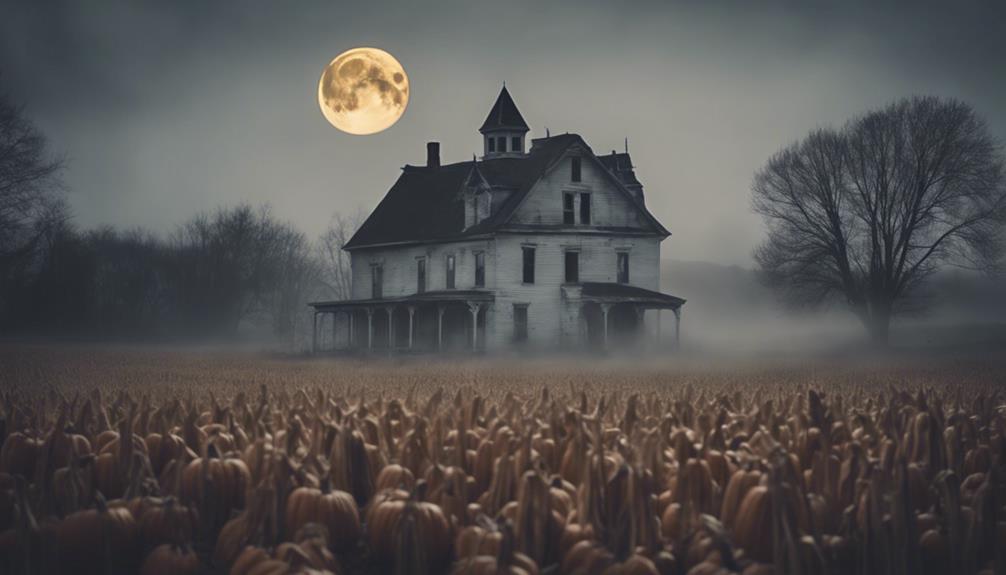
If you're looking for more spooky thrills after visiting The Haunted Farm, you'll be pleased to know that there are nearby haunted houses, spooky corn mazes, and ghostly hayrides to explore.
These attractions offer a variety of chilling experiences that are sure to keep your Halloween season filled with frights and fun.
Be sure to check out these options for a full night of haunting adventures in the Hendersonville area.
Nearby Haunted Houses
For those seeking more eerie adventures after visiting The Haunted Farm, other nearby haunted attractions await in Hendersonville.
- Nightmare Dungeon: Prepare to be terrified as you explore through this spooky haunted house filled with chilling surprises around every corner.
- Tormented Nightmares: Experience a heart-pounding journey through rooms filled with bone-chilling sights and sounds that will leave you screaming for more.
- Haunted Farm of Terror: This attraction offers a unique blend of haunted house scares and a haunted hayride for a truly unforgettable Halloween experience.
- Hillside Horror: Investigate the darkness of this haunted house where your worst nightmares come to life in a spine-tingling adventure.
- Pinhead's Graveyard: Wander through this haunted attraction featuring a haunted trail with horrifying scenes and ghastly creatures that will send shivers down your spine.
Each of these haunted houses near The Haunted Farm promises a hair-raising and thrilling experience that will leave you wanting more scares this Halloween season.
Spooky Corn Mazes
After exploring the nearby haunted houses in Hendersonville, venture into the dark and ominous cornfields of the spooky corn mazes for a thrilling Halloween experience.
These spooky corn mazes offer Halloween enthusiasts a chance to immerse themselves in intricate designs with terrifying surprises lurking around every corner. As you navigate through the eerie cornfields, you'll encounter spooky decor, interactive elements, scare actors, and special effects that will send shivers down your spine.
The haunted corn mazes provide a unique and immersive Halloween experience suitable for all ages, making them a must-visit attraction during the spooky season. Whether you're a seasoned Halloween fanatic or just looking for a fun and thrilling adventure, these haunted corn mazes are sure to deliver a memorable and spine-tingling experience.
Ghostly Hayrides
When visiting Dewberry Farm in Brookshire, TX, don't miss out on the popular haunted attraction of Ghostly Hayrides for a spooky and thrilling Halloween experience. As you prepare for this chilling adventure, here are some things to know about these ghostly hayrides:
- Ghostly Hayrides are popular haunted attractions near Dewberry Farm in Brookshire, TX.
- These hayrides offer a spooky and thrilling experience for visitors during the Halloween season.
- Participants can expect eerie encounters, spooky scenes, and chilling surprises along the hayride route.
- Ghostly Hayrides provide a unique way to explore haunted themes and enjoy a frightful adventure.
- Visitors can immerse themselves in the Halloween spirit by undertaking these ghostly hayrides near Dewberry Farm.
Embark on a journey filled with ghostly tales and spine-tingling moments as you venture through the haunted scenes on the Ghostly Hayrides near Dewberry Farm. Get ready for an unforgettable Halloween experience!
Unique Features of the Location
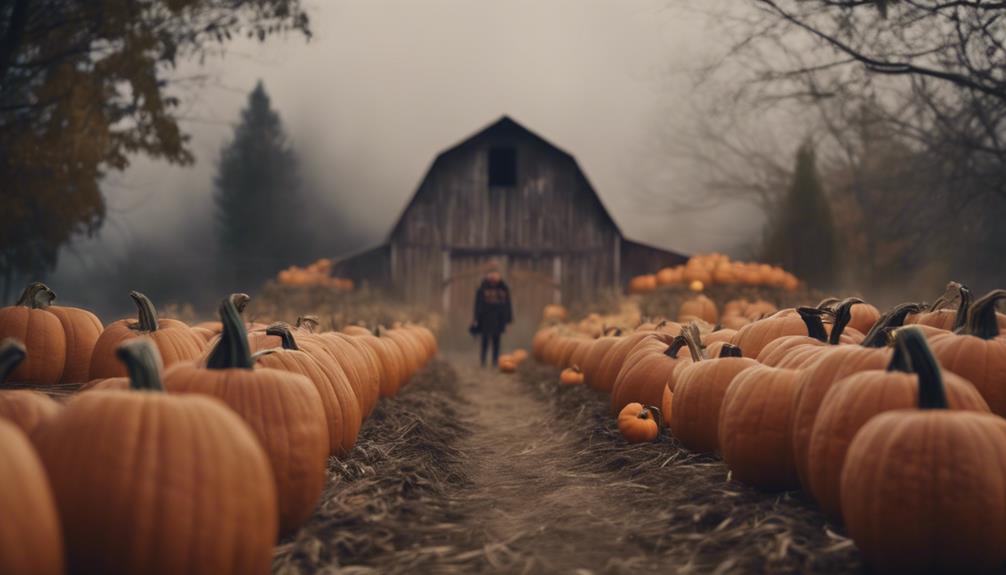
Nestled amidst the serene countryside of Brookshire, Texas, Dewberry Farm offers a variety of unique features that set it apart as a must-visit destination for fall festivities.
Situated on 364 acres, the farm provides a picturesque pumpkin patch showcasing over 50 varieties of pumpkins, creating a colorful backdrop for memorable autumn photos. Visitors can also enjoy scenic hayrides around the farm's expansive grounds, immersing themselves in the beauty of the rural landscape.
For those looking to take a piece of the farm home, Dewberry Farm boasts a charming country store offering farm-fresh produce and local goods, perfect for souvenirs or gifts. For the more adventurous guests, the farm provides the thrill of ziplining over its stunning landscape, offering a unique perspective of the surroundings.
With these distinctive features, Dewberry Farm offers a blend of natural beauty, fun activities, and local charm, making it an ideal destination for a fall day trip.
Seasonal Transformations
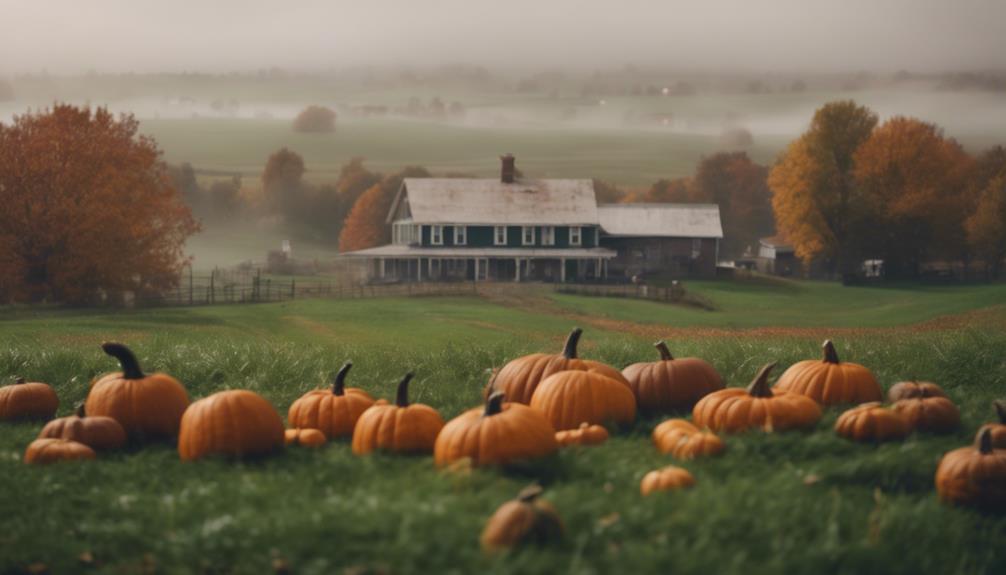
Upon arrival at Dewberry Farm during the Halloween season, you'll be greeted by a transformed landscape filled with spooky decorations and eerie ambiance. The farm undergoes a complete makeover, turning its usual charm into a hauntingly fun experience for visitors. Here's what you can expect:
- Decorations galore: From scarecrows to pumpkins, skeletons, and cobwebs, the farm is decked out in Halloween-themed decor that sets the mood.
- Twisted mazes: Corn mazes take on a creepy twist, offering a challenging and spooky adventure for those brave enough to navigate them.
- Haunted play areas: Get ready to explore haunted houses and eerie lighting that add an extra thrill to your farm visit.
- Haunted trails: The farm's surroundings transform into spooky paths filled with fog machines, creepy sounds, and special effects that keep you on edge.
- Immersive experience: Prepare for a completely different environment compared to the farm's usual appearance, immersing you in the spirit of Halloween from the moment you arrive.
Accessibility and Parking Options
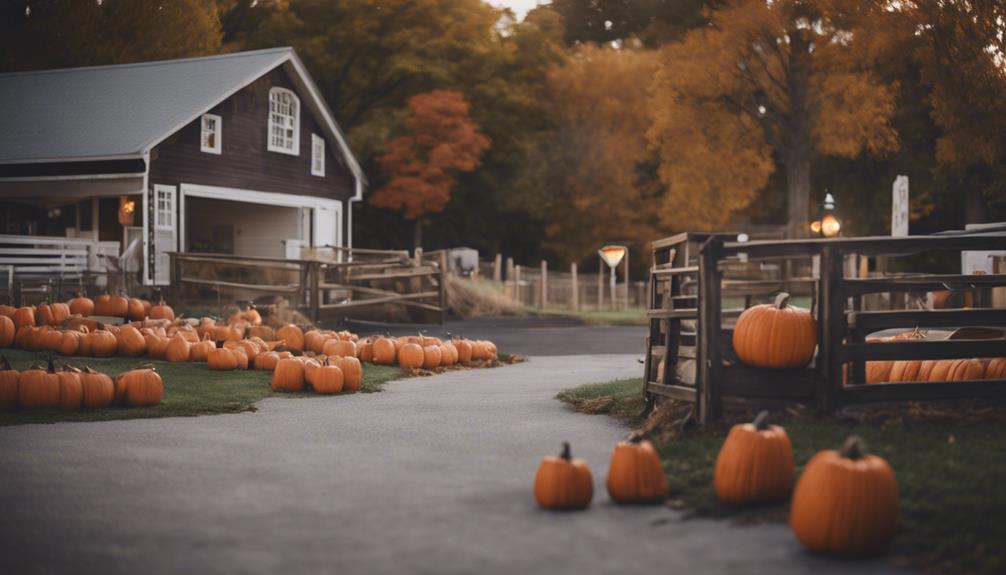
For guaranteeing convenient access and parking during your visit to Dewberry Farm, free on-site parking is available for all visitors. Whether you are coming with family or friends, you can rest assured that parking will not be an issue as you enjoy the farm's attractions. Additionally, Dewberry Farm is dedicated to providing accessibility services to make sure that all visitors have a pleasant experience. If you have specific accessibility concerns or require assistance during your visit, feel free to reach out to (714) 220-5200 for more information or to make necessary arrangements.
Here is a breakdown of the accessibility and parking options available at Dewberry Farm:
| Parking Options | Accessibility Services | Contact Information |
|---|---|---|
| Free on-site parking | Available upon request | (714) 220-5200 |
| Dedicated help for website-related inquiries | ||
| Exclusive pricing for Knotts Hotel guests |
Frequently Asked Questions
What Is the Scare Factor of Knotts Scary Farm?
You'll find Knott's Scary Farm to be off the charts in scare factor!
This event is all about ramping up the fear with its intense haunted mazes, scare zones, shows, and creepy creatures.
It's designed to immerse you in a chilling experience full of dread and suspense.
Not recommended for kids under 13 due to the sheer terror on offer.
How Many Years Does Knott's Scary Farm Have?
Knott's Scary Farm has terrified guests for over 50 years, making it a Halloween staple. Imagine the thrill of wandering through 160 acres of haunted mazes and scare zones, encountering roaming monsters at every turn.
This event has grown from a small affair to a massive Halloween extravaganza, drawing thrill-seekers and horror enthusiasts alike. With rides and attractions transformed into macabre settings, Knott's Scary Farm promises a terrifying experience year after year.
Can You Wear a Costume to Knott's Scary Farm?
You can't wear costumes if you're 14 or older at Knott's Scary Farm. For guests under 13, costumes are allowed with some guidelines to follow. Make sure your costume doesn't include masks, makeup that hides your face, or anything resembling weapons. This rule helps keep everyone safe during the event.
Knott's Scary Farm offers a fantastic Halloween experience even without costumes, ensuring all guests can enjoy the spooky fun.
What Is the Scariest Haunted House?
If you're looking for the scariest haunted house, you can't go wrong with The Haunted Farm in Hendersonville, NC. This spooky attraction offers a hair-raising experience with terrifying fun and thrilling surprises.
From chilling scares to heart-pounding frights, The Haunted Farm promises a night of pure terror for those brave enough to enter. Don't miss out on the chance to be thoroughly spooked at this excellent haunted house!
Conclusion
So, next time you're looking for a spooky good time, head on over to Halloween Farm's location. You won't be disappointed!
With its rich history, convenient location, and plenty of haunted attractions nearby, it's the perfect spot to get into the Halloween spirit.
Plus, the seasonal transformations and easy accessibility make it a must-visit destination.
Don't miss out on this hidden gem in the heart of Southern California – it's a real treat!
Hello, I’m Damien, the editor-in-chief here at Halloween Product Reviews. As a lover of all things Halloween, my goal is to be your one-stop resource. Whether you’re seeking costumes, decorations, or just looking to embrace the festive spirit, our expert team is here to assist in making your Halloween truly spectacular. My personal joy comes from dressing up, decorating my home, and diving into the Halloween festivities. I’m here to help make your Halloween as spooky and fun as possible!
-

 Halloween4 months ago
Halloween4 months agoMga Tauhan ng Florante at Laura Costume
-

 Halloween4 months ago
Halloween4 months agoCan You Go to Halloween Horror Nights While Pregnant?
-

 Halloween4 months ago
Halloween4 months agoSexy Harry Potter Outfits For Halloween
-

 Halloween4 months ago
Halloween4 months agoA Child in a Hitler Costume Causes a Stir Online
-

 Halloween4 months ago
Halloween4 months agoAlvin and the Chipmunks Costume Ideas
-

 Halloween4 months ago
Halloween4 months agoHow to Get Halloween Cookies in Cookie Clicker
-

 Halloween4 months ago
Halloween4 months agoHow to Protect Halloween Animatronics From Rain
-

 Halloween4 months ago
Halloween4 months agoWinx Club Costume For Adults





















